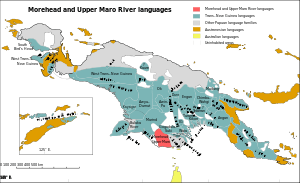Tonda languages
The Tonda languages form a branch of the Yam language family of southern New Guinea. There are over 10 languages.[2]
| Tonda | |
|---|---|
| West Morehead River | |
| Geographic distribution | Southern New Guinea |
| Linguistic classification | Yam
|
| Glottolog | tond1250[1] |
 Map: The Yam languages of New Guinea
Yam languages
Trans–New Guinea languages
Other Papuan languages
Austronesian languages
Australian languages
Uninhabited | |
Tonda languages share some areal features are shared with the Kolopom languages.[3]
Languages
The Tonda languages are:[2][4]
- Tonda / West Morehead River
- Arammba
- Central Morehead River: Anta, Kómnzo, Wára, Wérè, Kémä, Kánchá
- Warta Thuntai
- Bensbach River
- Upper Bensbach River
- Kanum
- Ngkolmpu: Ngkâlmpw/Ngkontar, Bädi
- South Kanum: Bârkâli-Smärki, Tämer
Notes (see Evans 2018: 681):
- Each terminal bullet point lists a different dialect chain.
- Ránmo is linguistically a dialect of Mblafe, but Ránmo speakers consider their language to be a separate, distinct language.
- Wérè is linguistically a dialect of Wára, but Wèré speakers consider their language to be a separate, distinct language.
Numeral typology
Tonda languages are unique for their base-6 numeral systems, which likely originated from counting yams (rather than fingers or body parts as with most other languages).[3]
gollark: They probably know, though.
gollark: ^
gollark: Ah, yes.
gollark: Like I said, controversy hour.
gollark: "I must respectfully disagree with the Honourable Gentleman here's suggestion", etc.
References
- Hammarström, Harald; Forkel, Robert; Haspelmath, Martin, eds. (2017). "Tonda". Glottolog 3.0. Jena, Germany: Max Planck Institute for the Science of Human History.
- Evans, Nicholas (2018). "The languages of Southern New Guinea". In Palmer, Bill (ed.). The Languages and Linguistics of the New Guinea Area: A Comprehensive Guide. The World of Linguistics. 4. Berlin: De Gruyter Mouton. pp. 641–774. ISBN 978-3-11-028642-7.
- Hammarström, Harald. (2009) Whence the Kanum Base-6 Numeral System?. Linguistic Typology 13(2). 305-319.
- West Morehead River
- Evans, Nicholas (2018). "The languages of Southern New Guinea". In Palmer, Bill (ed.). The Languages and Linguistics of the New Guinea Area: A Comprehensive Guide. The World of Linguistics. 4. Berlin: De Gruyter Mouton. pp. 641–774. ISBN 978-3-11-028642-7.
External links
- Timothy Usher, New Guinea World, Proto–West Morehead River (under construction 2020)
Further reading
- Grummitt, John and Janell Masters. 2012. A Survey of the Tonda Sub-Group of Languages. SIL Electronic Survey Reports 2012-018.
This article is issued from Wikipedia. The text is licensed under Creative Commons - Attribution - Sharealike. Additional terms may apply for the media files.